20 Moves to Master in 2020
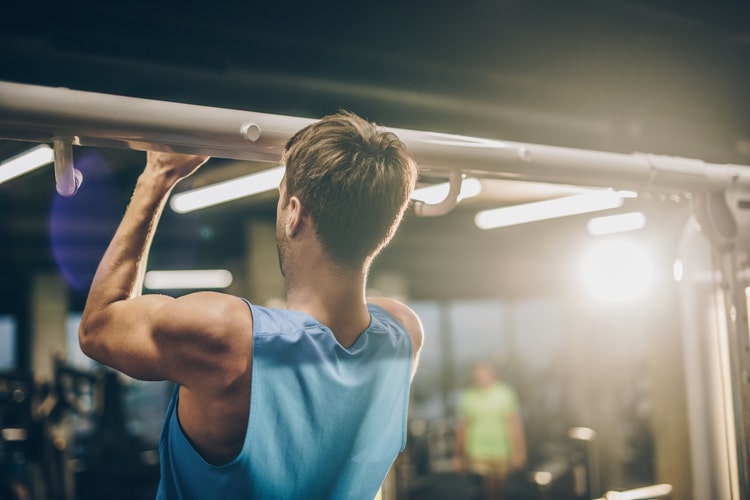
Workouts are our thing, we love them! And our members do too. Here are 20 of the top moves that you will need for 2020, selected and modeled by our incredible team. Many are classic moves that add value to any training goal; remixed into a workout, they help you move into the new year feeling fierce and ready for anything.
Pick one or two moves to try, keeping in mind the technique tips and advice to make them easier or harder based on your goals and personal needs. Add them to a workout once or twice a week and supplement with a cardio session, a 24GO daily challenge workout, your favorite class or a walk or run in nature.
With practice and consistency, you’ll soon master these moves and feel results. Even better, try them with a friend. No matter which ones you choose, you’ll find the addition is worth it!
Push-up
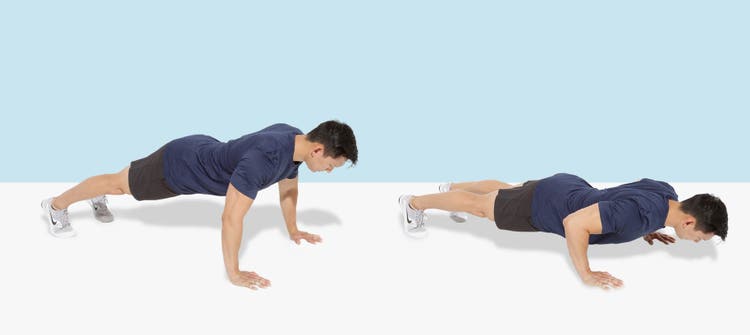
Model: Steven Au-Young, 24 Hour Fitness
At some point, everyone who’s into fitness has gotten into push-ups—and not just “add-them-into-my-workout” into them, but “seven-weeks-to-100-push-ups” into them and “100-push-ups-a-day” into them. But before you can take on a max push-up challenge, you’ve got to get the form right. So follow along to master the perfect push-up.
- Start in a long, strong plank position on your hands and toes. Make sure your feet are hip-width apart, and set your hands an inch or so wider than your shoulders.
- With a strong, straight back, lower your chest down until it hovers above the floor.
- Push the ground away to return to the starting position.
Tip: Mindset is everything when it comes to push-ups. Think “strong as steel from your head to your heels!”
Discover more Push-Up technique tips.
Front-Loaded Squat
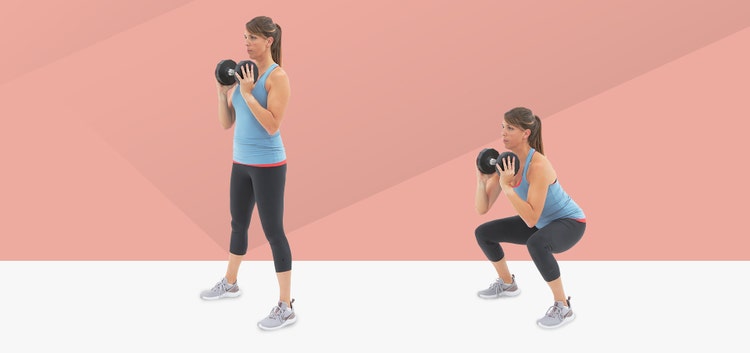
Model: Sherri Swan, 24 Hour Fitness
This move is a fixture in the strength and conditioning world, and it can be performed with a variety of weight options—including a dumbbell, medicine ball or barbell. Some would argue that the front squat with a barbell is a safer alternative to a back squat with a barbell, because there is less spinal compression and axial loading. This is a great strength movement that primarily works the entire anterior chain.
- Step back and set your feet up in a comfortable stance.
- Hinge your hips back and down as if you were sitting in a chair.
- Maintain length in your spine as you descend to a comfortable depth, and then stand back up to a vertical position.
Make it easier: Place a box behind you that you can sit on and find on each rep or perform with no weight.
Make it harder: Graduate to using a heavy barbell. Slow down your tempo, decelerating for a count of five.
Discover more Front-Loaded Squat technique tips.
Chest Press
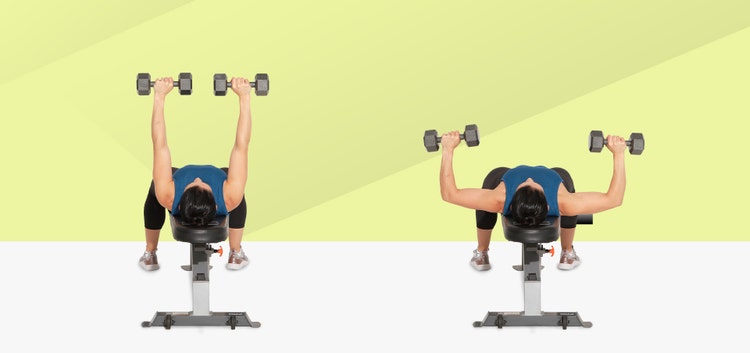
Model: Chellie Thomas
The chest press is the quintessential upper-body strength-training exercise. The bench press has been used by athletes, bodybuilders and fitness enthusiasts for decades. While the chest press with the barbell is common, there are plenty of variations of the chest press and many different tools that will use the same technique.
- Lie on your back on the bench with your eyes directly under the bar. Grab a wider than shoulder-width grip if using the bar. If you’re using dumbbells, extend your arms straight up to the ceiling with the dumbbells rotated 90 degrees and your wrists and elbows stacked over your shoulders.
- Lift the barbell off the rack and hold directly over your sternum for a count of two. Lower the bar slowly toward your chest. If you have the capacity and range of motion to lower it to your chest, then do so. Pause for half a second, then drive the bar toward the ceiling. The bar will stay directly over the middle of your chest.
- If you’re using dumbbells, bend your elbows and retract your shoulder blades on the bench as you slowly lower the dumbbells until your arms are bent at 90 degrees. Squeeze your pectoral muscles to drive the dumbbells up to the ceiling.
- Most people who want to improve their strength endurance will perform 12 to 15 repetitions or for 60 seconds.
- Make sure you are completely rested in your arms and chest before starting another set. Remember, your heart rate is going to recover before your muscles.
Make it easier: Use the chest-press machine.
Make it harder: Add more weight to the bar, try it with a narrow grip, use a bench that is on an incline or use dumbbells.
Discover more Chest Press technique tips.
Kettlebell Swing
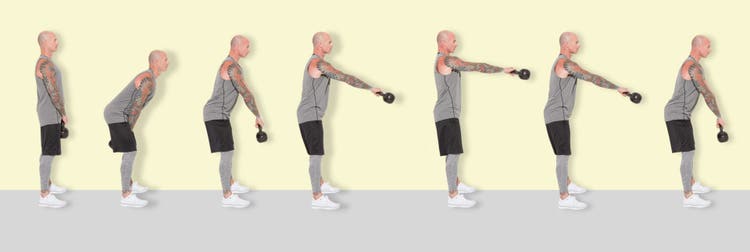
Model: Chris Alberts, 24 Hour Fitness
In the farm markets of 18th century Russia, kettlebells were used to weigh crops. In the 1800s, they were featured in strongman circus acts, and by the 1900s, they had become an important athletic training tool in Russia and Europe.
Today, kettlebell training and competition is a worldwide phenomenon that has produced different styles and competitive standards (like girevoy and hard style). But all forms of kettlebell training start with this one move: the kettlebell swing. It builds an important skill called strength endurance: the ability to generate force for an extended period of time.
- Hold the kettlebell with two hands in front of you.
- Start by hinging your hips back and forth to start the swinging action, letting your arms swing, too.
- Keep your arm straight as you swing it higher, hinging your hips back farther.
- While swinging the kettlebell forward, drive your hips forward and stand tall, squeezing those glutes together.
- As gravity pulls the kettlebell down, pull it back between your legs. Don’t let it drop below your knees.
Make it easier: Start with a soft sandbell, a dumbbell (which can be easier on the grip) or a medicine ball.
Make it harder: Swing faster or swing heavier. Kettlebell swings are no cakewalk. A 20-pound kettlebell is a beast to be reckoned with!
Discover more Kettlebell Swing technique tips.
Turkish Get-Up
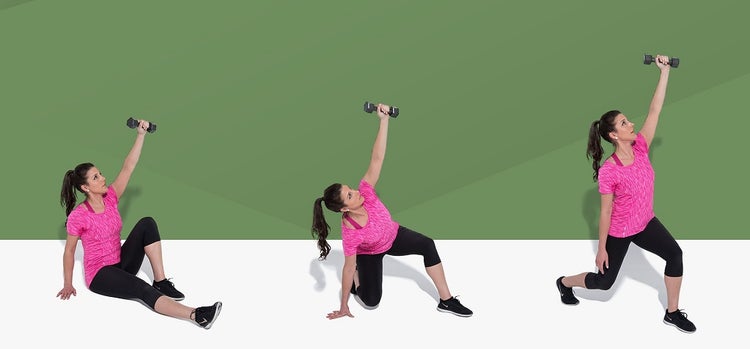
Watch the Video
Model: Maggie Jesse
The Turkish Get-Up (TGU) is a very complex but extremely rewarding move that challenges your stability and mobility at the same time during the entire move. It is also a drill that challenges you neurologically, as you have to navigate your body from the ground up and back down using a sub-maximal load. The TGU is the sum of multiple moves in all planes of motion, challenging every joint and muscle in the body, specifically the hips, shoulders, thoracic spine, quads and glutes.
- Lie on the floor with your right leg straight in front of you and your left knee bent, foot planted on the floor.
- Hold a dumbbell in your left hand. Press the weight straight above your left shoulder, making sure to keep your wrist and elbow completely straight. Extend your right arm next to you. This is the starting position.
- In one smooth movement, come up to your right elbow and then right hand. Punch upward with the weight and forcefully press your right hand into the floor so that your torso rises up and your weight shifts onto your right hand. Your right leg should remain straight. Keep your eyes on the weight the entire time.
- Without allowing your hand to leave the floor, rotate your right hand so that your fingertips are pointing at a 45-degree angle away from your body. Then, press away from the floor with your right hand to rise to a standing position, keeping your right leg and torso stiff as a board and your eyes on the weight.
- Reverse these steps to return to the starting position.
Tip: Doing too much too soon. Take your time before you move to the next step. Don’t rush; get it right. Start with body weight.
Make it easier: Take your time before you move to the next step. Don’t rush; get it right. Start with body weight.
Make it harder: Add some load, like a kettlebell, dumbbell or SandBell.
Discover more Turkish Get-Up technique tips,
Pull-Up
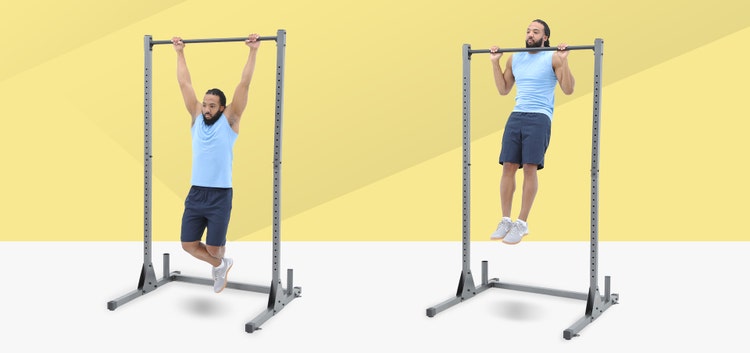
Watch the Video
Model: Glenn Payne III, 24 Hour Fitness
The pull-up is one of the most popular body-weight movements of all time. Having to fight gravity directly, it is also considered one of the most challenging moves to perform; often, it is used as a gauge for an individual’s upper-body strength.
- Grip a bar that is high enough so your feet are off the ground when in a dead-hang position.
- Grip the bar with a strong, tight grip. Actively pull yourself up so that your chin is at least level with the bar.
- Slowly lower yourself back down into the dead-hang position.
- From a dead hang, continue to repeat for desired number of reps.
Make It Easier: Use an assisted pull-up machine, or use a band that you step your foot in.
Make It Harder: Use a slower tempo, or add a weight vest.
Discover more Pull-Up technique tips.
Speed Skater

Watch the Video
Model: Maggie Chen, 24 Hour Fitness
This is a terrific exercise for lower-body strength and cardiovascular fitness. Even if you never step foot on a skating track, the leg power you will build with this drill makes it worth trying!
- Start by getting into an athletic ready position: Bend at your hips, knees and ankles, with your chest up and back straight.
- Jump out to your right side, landing on your right foot, in a single-leg version of the athletic position.
- You can counterbalance by bringing your left foot behind your right leg.
- Jump to your left side, landing on your left foot.
- Repeat from side to side, like you’re skating.
Make it easier: Instead of jumping, step to each side. If the single-leg balance is still tricky, touch your free leg down to the ground for balance.
Make it harder: Add some weight, like a medicine ball or ViPR PRO. Just remember to stay strong in your upper body.
Discover more Speed Skater technique tips.
Wood Chop
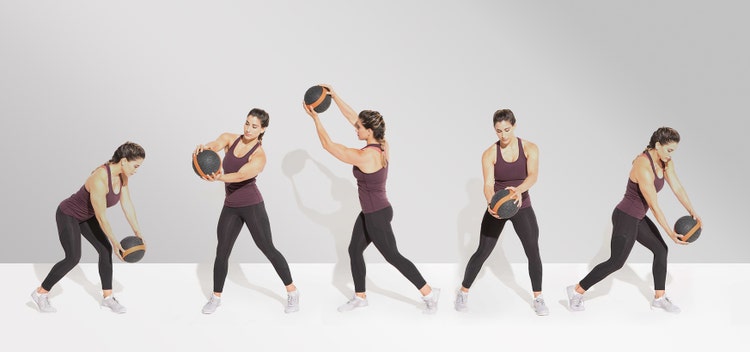
Model: Brooke Walsh, 24 Hour Fitness
Want powerful hips? Rock-solid abs? A strong back? Who doesn’t?! This classic movement isn’t just for farmhands and lumberjacks—it’s for anyone who wants to build a powerful movement foundation.
The wood chop is also a great functional exercise because it takes the body through movement in the transverse plane by rotating through the trunk, mimicking many of the movements we do daily (putting on a seat belt, putting a box on a high shelf).
- Begin in a standing position with your hands clasped or holding a weight, and your feet wider than hip-width apart.
- Squat down and rotate through your torso to bring your hands outside your left knee. Let your right heel come up off the floor as you twist.
- Quickly drive up out of your legs and rotate your torso to bring your hands up and across your body and above your right shoulder. Release your left heel to pivot on your left foot as you twist.
- Reverse the movement and twist through your torso as you swing your hands down across your body and bend your knees to bring your hands outside your left knee again.
- Quickly drive up, and chop down again.
- Repeat on the opposite side.
Tip: Control the weight—do not let momentum take over. Focus on quickly stopping the weight or your hands at the top and bottom of the move.
Make it easier: Slow it down and concentrate on the quick stop.
Make it harder: Add some load, like a medicine ball, dumbbell or SandBell.
Discover more Wood Chop technique tips.
Side Kick
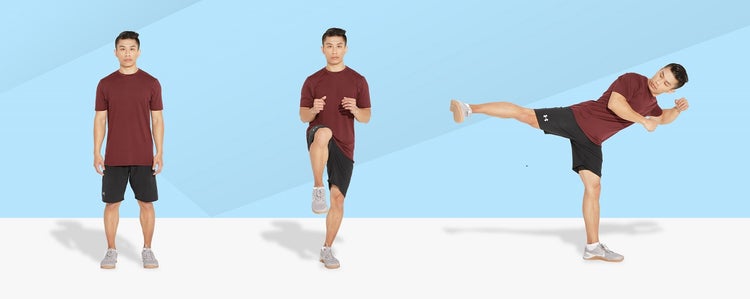
Watch The Video
Model: Vinh Duong, 24 Hour Fitness
The side kick is a staple and both a defensive and offensive move in Karate, Tae Kwon Do and other martial arts, and it has been especially popularized in Tae Bo, Turbo Kick and Les Mills BODYCOMBAT. While Bruce Lee, Chuck Norris and the Avengers made this move look very easy in the movies, there are a number of steps and techniques to keep in mind.
- Shift your weight onto one leg as your base supporting leg.
- Step the heel of your supporting leg toward the direction of the kick.
- Lift your kicking knee across your body—this is your chamber and sets the height of your kick.
- Extend your leg out to the side, aiming for the target zone of knee, thigh or hip level. Make sure to keep your heel up, toes down and strike with the outside of your foot.
- Retract your knee—that is, return to your chamber—and bring your kicking foot down to return to standing.
- As you get better balance, you can work on increasing the velocity of the kick.
- Keep your core tight and focus on controlled movement.
Make it easier: Practice the chamber only. If you really need it, use a support like a chair or a body bar to help you balance, or have a trainer or friend nearby to support you.
Make it harder: Make it compound movement. Transition from other movements into the side kick. For example, step laterally and down into a squat, and then step back out and execute a side kick.
Discover more Side Kick technique tips.
Deadlift
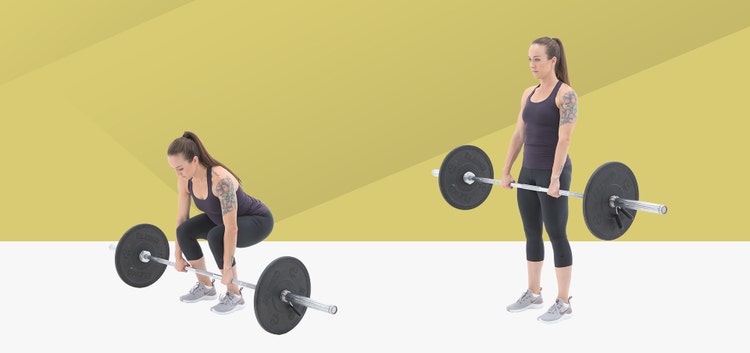
Watch the Video
Model: Krista Jacobs, 24 Hour Fitness
This is one of the most popular exercises in fitness used in weightlifting, bodybuilding, powerlifting, and strength and conditioning. This exercise is often measured to help gauge total-body strength, and competitions take place all around the world to judge the amount of weight someone can deadlift. Additionally, the barbell deadlift is used in all facets of fitness, considering we need to be able to pick things up and down off the floor our entire lives.
- With your feet about shoulder-width apart and your toes pointing forward, hinge your hips back and grab the bar sitting on the ground in front of your feet.
- Driving your feet firmly into the ground with a solid grip on the bar, maintain a long spine throughout the entire movement as you stand up driving your hips forward. Finish by standing up tall in a vertical position.
- Hinge your hips back to descend the bar back down to the floor, and repeat for your desired amount of reps.
Make it easier: Perform from a rack position. You also can sub the barbell for a center-hold kettlebell deadlift.
Make it harder: Increase load or number of reps.
Discover more Barbell Deadlift technique tips.
Squat Thruster
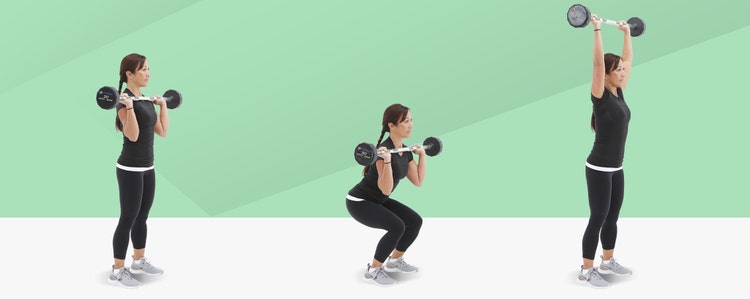
Watch the Video
Model: Jiji Pollock, 24 Hour Fitness
The squat thruster is a staple in many metabolic conditioning programs because it is a very taxing movement on your muscular, cardiovascular and nervous systems. This move is one of the most popular total-body movements being used today.
- Grab a weighted bar or dumbbells and bring them up to a front-carry position in front of your shoulders with your elbows slightly out in front of your body.
- Stand tall with your feet slightly wider than hip-width apart.
- Bring your hips down and back as if you were sitting in a chair to come into a squat.
- As you drive out of your heels to stand, drive the weight toward the ceiling, fully extending your arms overhead.
- Once at the top, lower the weight back down to shoulder level as you begin to descend with your hips again and repeat.
Make it easier: Use one weight for both hands (medicine ball, dumbbell, kettlebell).
Make it harder: Increase load or rep, alternate the pressing arm with each squat or use a heavy barbell.
Discover more Squat Thruster technique tips.
Single-Leg Romanian Deadlift
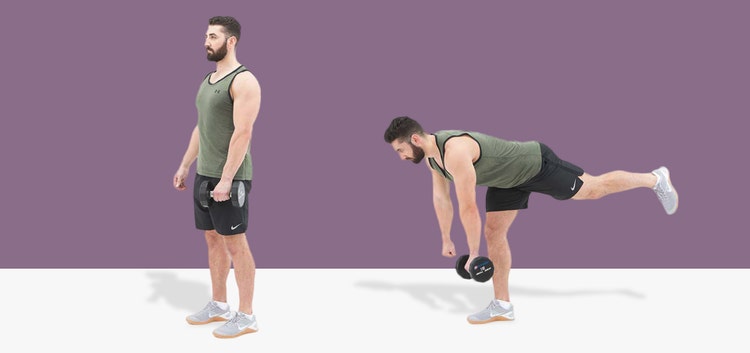
Watch the Video
Model: Nick Routson, 24 Hour Fitness
This is such a big-bang-for-your-buck movement. It’s a single-leg balance plus a hip hinge, and it builds deep strength in your back, hips, glutes and hamstrings. Named after a Romanian lifter in the early ’90s, it has become a mainstay in power and sports training.
- Stand with your feet hip-width apart, holding a dumbbell in one hand or no weight at all.
- Shift your weight so you’re standing on one leg (the same side holding the dumbbell).
- Start moving by hinging forward at your hips as your free leg extends out behind you.
- Lower the dumbbell to the height of your knee or slightly below, then return to the starting position.
Make it easier: Try it with no weight at all. If you can’t balance for the whole movement yet, try doing it in a split stance, with your back toe on the ground for stability.
Make it harder (pictured): Hold the dumbbell in your opposite hand and stand on your other leg.
Discover more Single-Leg Romanian Deadlift technique tips.
Barbell Snatch

Watch the Video
Model: Logan Schwartz
The snatch is one of two events in competitive Olympic weightlifting. (The clean-and-jerk is the other.) The snatch is composed of three lifts that look like one. You have the deadlift, the pull and the catch. When performed correctly, it looks like one fluid movement.
The most important thing to consider when adding this to your resume of successful movements performed in the gym is that this move is more than an exercise. It is a skill. It is part of a sport. It requires tremendous particular attention to the technique. There is a very high rate of injury in this movement because of the velocity and precision needed for this sport.
Part 1: The deadlift
- With the barbell on the ground, it should be starting at midshin height. With weights on the bar, the bar will be at about midshin. If the bar is empty, prop it up on blocks to create the correct starting height.
- Assume a somewhat wider stance so that your feet are wider at your toes than your heels. Everyone will have a different stance based on length of leg, so play with a position that makes you feel you can get the best leverage and vertical pull position.
- Get close enough to the bar so that your shins will touch the barbell. Hinge your hips back and grab the bar with a very wide grip. Using a hook grip of the bar is best for heavy pulling and keeping your arms relaxed.
- Keep your back straight and push the ground away from you to lift the bar to hip height. The bar must stay in contact with your shins and thighs on the way up. Brush your body with the bar.
Part 2: The pull
- When the bar reaches the height of your hips, it is time to transition to the pull. As the bar continues its momentum vertical, you need to simultaneously start shrugging your shoulders and rising with your calves. This upward momentum of the bar is accelerated by the vertical extension of your pelvis, heels and shoulders. The result will be that the bar will travel as high as possible (depending on the load and force required to move it). If the bar is light, it will travel high. If it is very heavy, it will not travel as high.
- Keep your arms relaxed because tension in your arms will slow down the momentum of the bar. Keep the bar moving in a vertical path.
- At the point of maximal height of the barbell, it is time to receive or catch the bar.
Part 3: The catch
- With your elbows pointing toward the sky and your hands below the height of your elbows, pull yourself down under the barbell by dropping into a squat while at the same time whipping your hands through the ceiling. Be prepared to have to violently stiffen your body to time catching the barbell overhead in a strong overhead squat position. The barbell will be directly behind your ears, over your shoulders and pass through the center of gravity to the midpart of your foot. Imagine a straight line drawn from the barbell through the midline of your body.
- Once you have received the barbell in the squat, you must stand up with the weight overhead.
You have successfully performed one rep of the barbell snatch.
Make it easier: Perform the one-arm dumbbell power snatch. This is a supplemental movement that involves all the coordination of the barbell snatch with less load and complexity in the catch phase of the movement.
Make it harder: Perform a barbell snatch from blocks. Set the barbell on blocks that are about knee height. This makes the movement so much harder because it is difficult to generate leverage and velocity. Your technique must be perfect to successfully snatch the barbell.
Discover more Barbell Snatch technique tips.
Tuck Jump
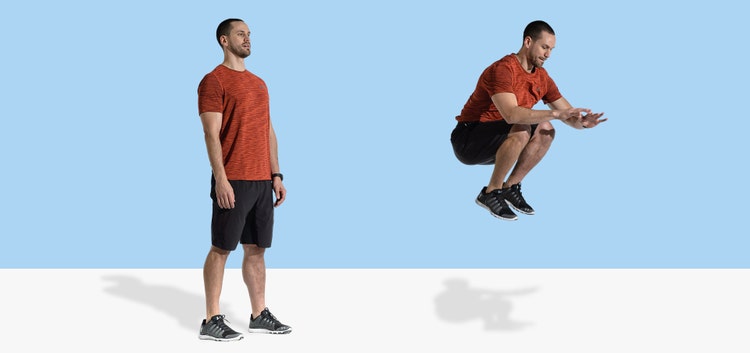
Watch the VideoModel: Brandon Garcia
It might not be the first move that comes to mind when we think about fitness, but tuck jumps are the exercise when we’re talking about true athleticism. These elastic jumps help us build explosive power and springiness by training plyometric actions in our muscles and elastic recoil in our fascia.
- Set your feet shoulder-width apart.
- Start with a few little hops that get higher and higher.
- Once you’re feeling bouncy, jump high and drive your knees up toward your chest.
- As you descend, prepare to land and instantly leave the ground again.
- Try to land and take off from the same place every time.
Make it easier: Try vertical jumps without the tuck, one at a time. As you feel more comfortable, add more jumps and then the tuck.
Make it harder: Make it a traveling tuck jump by moving forward with each jump.
Make it even harder: Move side to side with each jump.
Discover more Tuck Jump technique tips.
Dead Bug

Watch the Video
Model: Jiji Pollock, 24 Hour Fitness
The dead bug is a functional core movement that is used to help create spinal stability and take stress off the spine by allowing gravity to take pressure off the back. The change in orientation from long days of sitting causes compression in the spine. This is a great movement to decompress the spine and relax while also igniting the core.
- Lie on your back with your hands extended above you, arms straight and your wrist, elbow and shoulder stacked in one line.
- Your knees will be at 90 degrees to your hips, and your shins will be presenting parallel to the ground. Make sure your feet are flexed at 90 degrees to your shins or perpendicular to the ground.
- With your back flat on the ground, press your body into the ground. Extend your right arm straight back behind your head while simultaneously extending your left leg out to hover over the ground.
- Return your arm and leg to start, then repeat with the opposite limbs, extending your left arm and right leg.
Make it easier: Lower your leg to tap your toes to the ground instead of extending.
Make it harder: Try to do this on a BOSU ball with the dome pointing up.
Discover more Dead Bug technique tips.
Russian Twist

Watch the Video
Model: Raymond Bentley, 24 Hour Fitness
Just like the salad dressing, no one knows how this abdominal drill became “Russian,” but (again, like the dressing) it’s too good to worry about the name. No core-training program or ab day would be complete without the oblique conditioning you’ll get from the Russian twist. If you’re already on your way to six-pack abs, this drill might help you bump it up to an eight-pack. For the rest of us, the loaded twisting makes a pretty fantastic core challenge.
- Sit on the floor with bent knees, holding a medicine ball, SandBell or other weight in your lap.
- Lean back, lift your feet off the floor, keeping your knees bent, and hold the weight out in front of your torso.
- Twist by rotating the weight to your left, keeping your eyes on the weight so your whole upper body rotates together.
- Keep your legs still as your upper body twists.
- Slowly come back to center, and repeat on the other side. Do as many reps as you can without dropping your feet to the floor.
Make it easier: Keep your feet on the floor, use a lighter weight or don’t use any weight at all.
Make it harder: Lean back farther, use a heavier weight or try scissoring your legs at the same time.
Discover more Russian Twist technique tips.
Single-Leg Hip Bridge
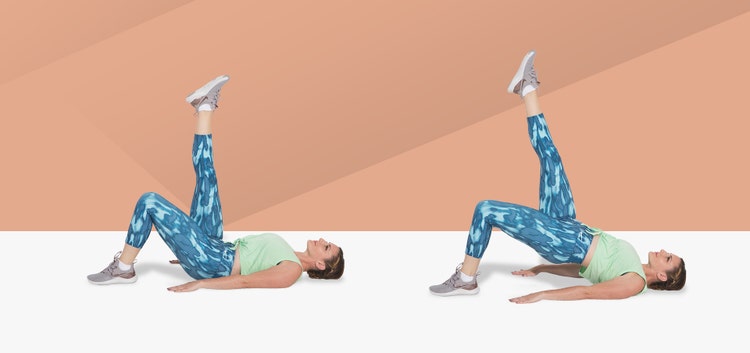
Model: Tiffany Hamlin, 24 Hour Fitness
A hip bridge is one of the simplest yet most effective moves for your posterior chain, specifically your glutes. Often chosen less than double-leg movements, single-leg movements host a myriad of benefits not available on two legs, including building rotary stability, balance and the engagement of smaller muscle groups.
- Lie on your back with your hands planted firmly on the floor by your sides.
- Bring one knee in toward your chest and hold it in there.
- Bend your other leg and have that foot planted firmly on the ground.
- Drive your foot through the ground as you raise your hip off the ground, driving your bellybutton to the ceiling until you reach full hip extension.
- Hold at the top for about one second before lowering back down to the ground with control.
Make it easier: Start with a double-leg bilateral hip bridge.
Make it harder: Place a weight (barbell, dumbbell, plate) along the crease of your hip and elevate your upper back on a bench.
Discover more Single-Leg Hip Bridge technique tips.
Bicycle Crunch
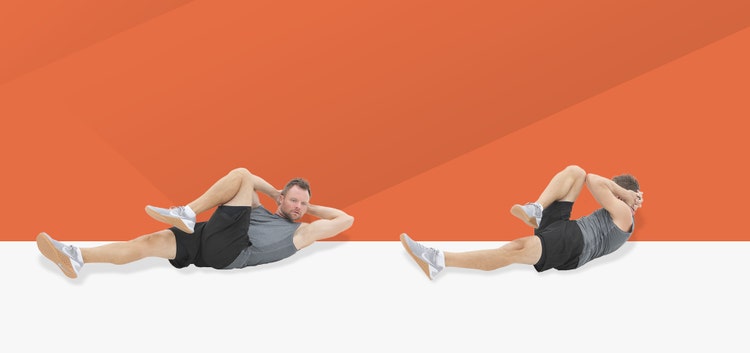
Watch the Video
Model: Logan Schwartz
The bicycle crunch has been a staple in the fitness community for many years. This exercise requires not only core strength but also full-body synchronization and timing between upper and lower body.
- Lying flat on your back, bring your hands behind your head with both legs starting straight out slightly off the ground.
- Lift one leg up, driving your knee toward your chest as you bring in your opposite-side elbow toward that knee, lifting your upper back off the ground.
- Move reciprocally with your opposite knee to elbow, keeping your upper back off the ground for a desired amount of time or repetitions.
Make it easier: Keep your knees bent and tap your toes to the ground instead of extending your legs.
Make it harder: Place a mini-band around your mid-foot, stretching out the band as you bicycle.
Discover more Bicycle Crunch technique tips.
Downward-Facing Dog
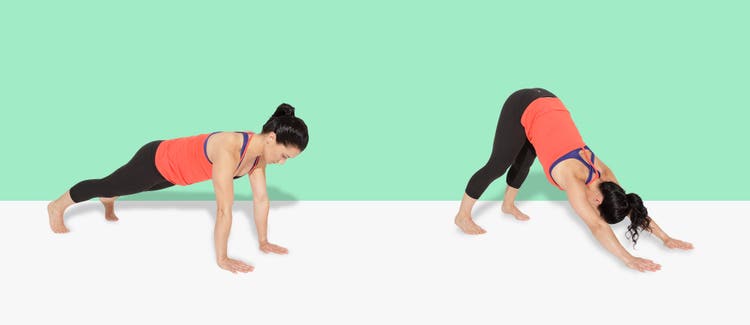
Model: Chellie Thomas
This is the yogi-est of all yoga moves (in North America, at least). Adho mukha śvānāsana (as it’s known more formally) is an incredible classic pose for mobility and body-weight strength and self-awareness.
- Begin in tabletop position, with arms straight, hands under shoulders and knees under your hips, toes on the ground. Bring your knees to hover off the floor.
- Straighten your legs, creating one long line from head to heels.
- Press into the floor with your hands and feet as you lift your hips up and back toward the ceiling.
- Let your neck relax and allow your head to sink down and align between your arms. Keep your gaze soft and look through your feet. Create a long, straight line from your hands to your hips and from your hips to your feet.
- Hold the pose for anywhere from three to 60 seconds or more (to your comfort), then gently release down to plank or tabletop and repeat if desired.
Make it easier: Lift up high on the balls of your feet and bend your knees softly to lengthen the spine and focus on the stretch in your back. Or bend one knee at a time and alternate bringing your heels off the ground, pedaling through your feet. You also can try this move with your hands on yoga blocks or a chair.
Make it harder: The goal is not harder, but to gain more understanding, space and alignment in the pose. You wake up Downward-Facing Dog through a roving focus on the alignment and the engagement and release of every muscle in your body. Practice building strength and endurance in the pose by holding it longer with a conscious breath and roving your attention through each square inch of your body, holding the pose and managing the thoughts that arise as you aim to maintain integrity of alignment.
Discover more Downward-Facing Dog technique tips.
Recovery Breathing
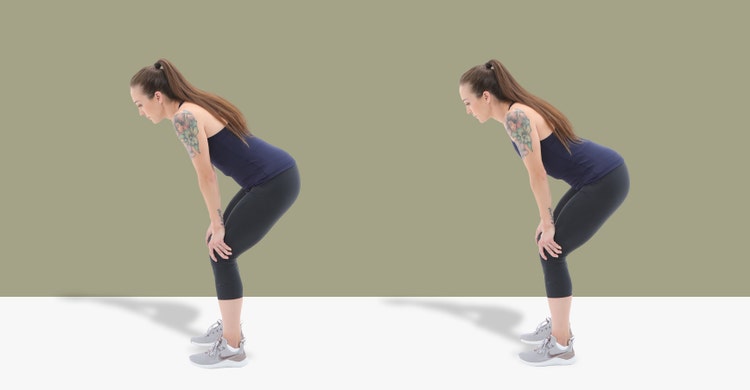
Model: Krista Jacobs, 24 Hour Fitness
Most breathing techniques focus on yoga, stress management or meditation. But we can use breathing techniques to help us get the most out of more intense workouts, too. Have you ever played a sport or taken a high-intensity class that left you breathless? Master this technique to help slow your breathing and heart rate so you can recover faster.
- Bend at your hips and knees, sticking your butt out. Put your hands on your knees.
- Close your mouth and breathe in and out through your nose.
- As your heart beat starts to slow, try to take a breath in for two seconds and then out for two seconds.
- Increase the length of each breath gradually, working your way up to four seconds in and four seconds out.
- Continue this until you are fully recovered and able to breathe normally again.
Discover more Recovery Breathing technique tips.
Photo credit: skynesher, Getty Images; Tom Casey, box24studio.com